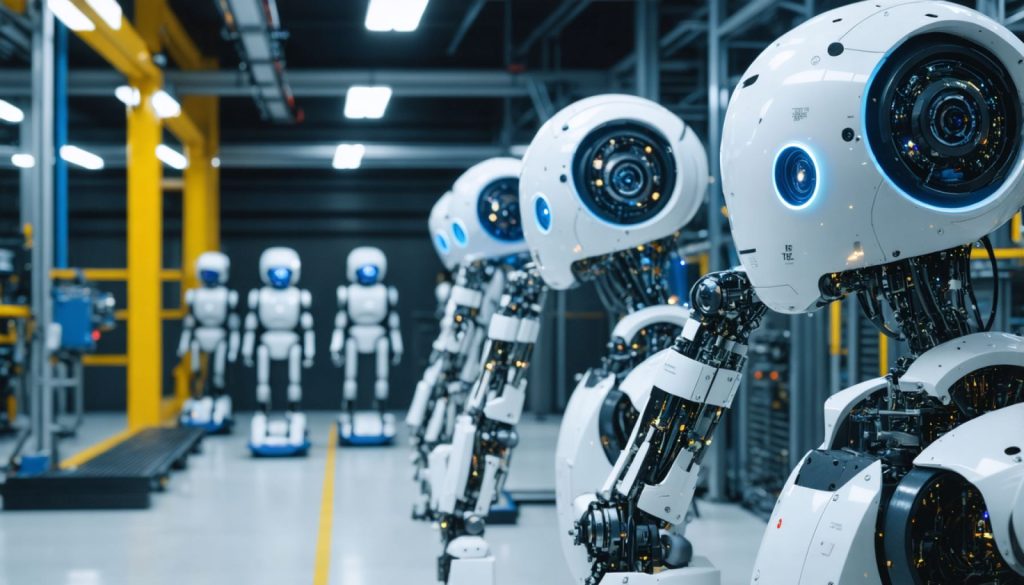
- Collaborative robots, or cobots, are transforming industries by working alongside humans, rather than replacing them, enhancing teamwork and capability.
- An event at Greenville ONE Center, hosted by Furman University, explores the integration and future of cobots in various sectors.
- Experts in robotics will discuss how cobots perform tasks ranging from complex surgeries to precision manufacturing, driving innovation.
- This conversation will focus on ethical implications and ensuring technology advances responsibly to benefit humanity.
- A South Carolina-based cobot startup will add a local perspective to the global dialogue on robotics and human collaboration.
- The event features networking opportunities, a fireside chat, and insights moderated by Catherine Hayes of the South Carolina Research Authority.
- Attendees will engage with themes of innovation, challenge, and the role of cobots in future workplaces, inviting reflection and collaboration.
A quiet revolution is unfolding in the heart of Greenville, where technology, ingenuity, and human endeavor intersect. In the modern landscape of automation, collaborative robots, or cobots, are setting the stage for a remarkable transformation in industries across the globe. This Thursday, Furman University will ignite the conversation around these innovative machines at the Greenville ONE Center, delving into the intricacies of a world where humans and robots work side by side.
The gathering, part of the esteemed Advantage Greenville series, offers a free foray into the frontier where robotics meet human collaboration. It promises to demystify how these mechanical assistants are being seamlessly integrated to enhance human capabilities, from performing complex surgeries to handling rigorous manufacturing tasks with precision once thought unachievable by machines alone.
Three luminaries in the fields of robotics and manufacturing will headline the discussion. These global leaders will shed light on the transformative journey of cobots, decoding their current applications that solve real-world problems and spark innovation across diverse sectors.
The spark of enthusiasm around cobots is fueled by their ability to work alongside, rather than replace, human labor, reshaping the very idea of teamwork. As these robots enter workplaces, they raise important questions about the ethics of automation, ensuring that technological advancements serve humanity with responsibility and foresight. This exploration will be brought into focus by a South Carolina-based cobot startup, adding a local flavor and singular insights into this global dialogue.
Participants will also be treated to a fireside chat featuring insights on the evolving dynamics between humans and their robotic counterparts, moderated by Catherine Hayes from the South Carolina Research Authority. Expect a compelling narrative of innovation, challenge, and ethical considerations, inviting attendees to reflect on the role cobots will play in the myriad facets of work.
The event itinerary promises bountiful opportunities for connection and reflection, beginning with a networking breakfast that sets the stage for the main event. As knowledge seekers gather to absorb, question, and collaborate, the spirit of exploration and shared insight resounds, promising to leave an indelible mark on participants.
For those curious to uncover the symphony of human-robot collaboration, this is more than just a panel discussion—it’s an invitation to witness the dawn of a new era in automation. Don’t miss the chance to be part of this transformative dialogue. Registration for the event is simple and free, representing a golden opportunity to witness the future unfold today.
How Cobots Are Revolutionizing Industries: Insights from Greenville’s Robotics Forum
Understanding Cobots: A New Workforce Paradigm
Collaborative robots, or “cobots,” are an evolution in robotics technology designed to work alongside humans, enhancing productivity and safety. Unlike traditional industrial robots, which often require separation from human workers for safety reasons, cobots are engineered to operate in close proximity, promoting a more seamless integration of human and robotic efforts.
Key Features of Cobots:
– Flexibility and Adaptability: Cobots can be easily reprogrammed and repurposed for various tasks, making them ideal for dynamic work environments.
– Safety-Centric Design: Equipped with advanced sensors, cobots can sense human presence and avoid collisions, significantly reducing workplace injuries.
– Cost-Effectiveness: Compared to traditional automation robots, cobots are generally more affordable and quicker to deploy, providing companies with a rapid return on investment.
Industry Applications and Case Studies
1. Manufacturing: Cobots are employed to perform repetitive tasks like assembly, quality control, and packaging, allowing human workers to focus on more complex processes. This has been highlighted by companies such as Universal Robots, who have successfully deployed cobots in manufacturing sectors worldwide.
2. Healthcare: Cobots assist in precise tasks such as surgical procedures and rehabilitation therapies. Their precision and reliability can lead to shorter recovery times and improved patient outcomes.
3. Logistics: In warehouses, cobots manage inventory, organize supplies, and even work alongside human packers, improving efficiency and accuracy in order fulfillment.
Market Forecasts & Industry Trends
The global cobot market is expanding rapidly, with projections estimating it will reach a valuation of over $9 billion by 2025 (Grand View Research). This growth is driven by advancements in AI, machine learning, and the increasing demand for automation in small to medium-sized enterprises.
How-To Steps for Implementing Cobots
1. Identify Tasks: Assess which repetitive or dangerous tasks can be automated safely and effectively.
2. Evaluate Options: Research and choose cobots that meet the specific needs of your industry and tasks.
3. Pilot Program: Implement a small-scale pilot to evaluate performance and gather feedback from human operators.
4. Train Employees: Offer training programs to teach workers how to interact and collaborate with cobots efficiently.
5. Expand Use: Scale the implementation based on results and optimize workflows to fully integrate cobots.
Pros & Cons Overview
Pros:
– Enhanced productivity
– Increased safety
– Cost savings
– Flexibility in operations
Cons:
– Initial setup costs
– Training requirements
– Possible job displacement concerns
Ethical Considerations and Challenges
The integration of cobots raises questions about job displacement and the evolution of labor markets. While cobots are designed to complement human workers rather than replace them, it is crucial to establish policies that ensure technological progress benefits everyone.
Recommendations:
– Foster skill development programs to upskill workers for roles alongside cobots.
– Engage in continuous dialogue about the ethical implications of robotics and automation.
Conclusion and Actionable Tips
Attendees of the Greenville robotics forum are poised to gain invaluable insights into the world of cobots, making it a must-attend event for those in industries poised for automation.
Quick Tips for Adopting Cobots:
– Start small and scale up.
– Focus on tasks that are repetitive and high precision.
– Engage your workforce early to alleviate fears and promote collaboration.
Cobots herald a significant shift in how industries function. By leveraging their capabilities, companies can achieve unprecedented efficiencies while fostering innovative human-robot collaboration.
To stay updated on robotics innovations, visit Furman University.



